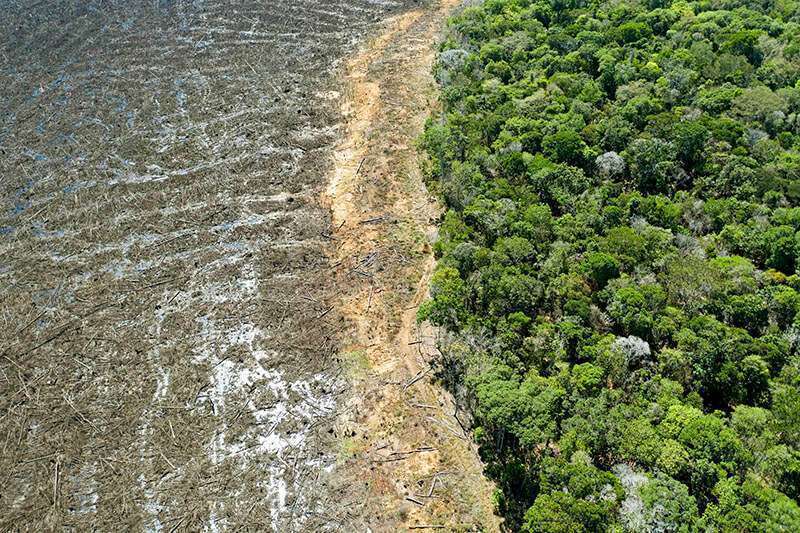In 18 years, the equivalent of the area of Spain has been deforested in the Amazon

The group of researchers and NGOs grouped around the Amazon Network of Socio-Environmental and Geographic Information (RAISG) denounced in a report the serious deterioration of the Amazon rainforest, where deforestation reached 513,016 km2 between 2000 and 2018, an area approximately the size of Spain.
The RAISG points out that the atlas presented, 'Amazonia under pressure', aims to attract the attention of those in power and to seek alternative development policies that do not continue the degradation of the Amazon. Carmen Josse, director of the environmentalist foundation EcoCiencia, which is part of the project, told the EFE news agency that despite "information and evidence of what is happening, there is no action".
The Amazon rainforest stretches across Brazil, Colombia, Peru, Bolivia, Ecuador, Venezuela, Surinam, Guyana and French Guiana, covering 47 million inhabitants, including indigenous communities. However, Brazil is the main culprit because despite the fact that 62% of the jungle is located in its territory, 85% of the deforestation has taken place in its territory.
Various activities are blamed for the deforestation of the Amazon. According to RAISG, agricultural activity is responsible for 84% of deforestation. Between 2000 and 2020, the areas dedicated to this activity increased by 81.5%, experiencing a slight decrease in 2012.
Hydroelectric plantations, which are very important in the area due to the opportunities offered by the flow of the Amazon River, are also a cause for concern. As of March 2020, 833 hydropower plants existed or were planned, with the majority of the projects located in Brazil (52%). Ecuador, despite constituting 1.5% of the Amazon, has 18% of the hydroelectric plants.
The transport of goods and raw materials to the ports also contributes to deforestation. The road density, calculated on the basis of the extension of roads and territory is 18.7km/1,000 km2, with Colombia, Peru, and Venezuela contributing most.

In terms of oil production, it occupies 9.4% of the Amazon, with Ecuador representing 51.5% of the total, followed by Peru (30.9%), Bolivia (28.8%), and Colombia (27.3%). Over the last decade, Peru, Brazil and Colombia have reduced their oil activity in the Amazon, while Bolivia and Venezuela have increased it, although in the case of Venezuela it only accounts for 2.7% of the total.
The increase in the price of gold on the international market, as well as the importance of other minerals such as coltan and niobium, are incentives for the expansion of mining activity. It accounts for 17% of the region and 96% is concentrated in Brazil, Venezuela, Guyana and Peru, with Brazil accounting for 75%. Between 2012 and 2020, the region experienced a 10% increase in mining areas, although the area of the Amazon occupied by mining activity decreased by 306,250 km2. Projects such as the Orinoco Mining Arc, created in Venezuela in 2016, pose a risk to environmental preservation and indigenous lands, as it covers 24% of the Venezuelan Amazon.
Fire is also a relevant factor in this issue. Traditionally used by indigenous communities for the development of their economic activity, there is no evidence of substantial changes to the landscape. But currently, used on a large scale by other actors, in addition to fires caused by climate change, it has meant that between 2001 and 2019, 13% of the Amazon forest has been affected by the advance of fire, representing 1.1 million km2 , the equivalent of Bolivia. The countries most affected are Bolivia itself, Brazil, Venezuela and Colombia. Fires are increasingly difficult to control and are spreading more quickly. In 2019, the magnitude of fires in the region triggered a wave of global concern.
The illegal economy is often beyond the control of state agencies. It generates billions of dollars each year, especially in timber extraction, mining and illicit crops. At the same time, "forest roads" are growing, i.e. routes that criminal groups create illegally for the transport of their goods, and which do not appear in the official map.
For example, with regard to timber extraction, organisations such as Human Rights Watch (HRW) state that "Criminal networks have the logistical capacity to coordinate large-scale timber extraction, processing and marketing, while at the same time they hire armed men to intimidate, and in some cases, kill, those who try to defend the forest". In countries like Colombia, it accounts for 47% of the timber on the market.
Colombia is precisely the country most affected by illicit crops, specifically cocaine, followed by Peru. Armed and structured groups invade territories, displacing native communities to supply mainly the market in Europe and the United States.
Brazil and Venezuela are also the countries most affected by illegal mining. The former accounts for 53.8% of the 4,472 pockets of illegal mining, while the latter accounts for 32% despite the fact that only 5.6% of the Amazon is in its territory.









